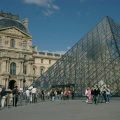Museum housing numerous pieces from Egypt, representing all the Muslim dynasties in Egypt.
It's what many consider to be the most beautiful museum in the world. The origins of the Louvre date back to the 12th century, when Philippe Auguste decided to build a stronghold there, and the idea of opening a museum there was not born until the French Revolution. At the end of the 20th century, under the presidency of François Mitterrand, architect Pei built a glass pyramid in the courtyard of the Carrousel. A symbol of the museum, the glass pyramid was widely criticized at the time of its opening, but is now widely accepted as the entrance to the museum. Eight major departments, spread over three wings - Richelieu, Denon and Sully - serve as reference points: Oriental, Egyptian, Greek, Etruscan and Roman antiquities, Islamic art, sculptures, objets d'art, paintings and graphic arts. Thousands of pieces are on display in these venerable buildings: only 7,500 for paintings, including the famous Mona Lisa. At the same time, numerous temporary exhibitions are organized here: the 13th-century artist Cimabue, "Les Figures du Fou" from the Middle Ages to the Romantics, and masterpieces from the Torlonia collection are just some of the events to be discovered. From the museum, take the time to admire the incredible view as far as the Arc de Triomphe and, beyond, La Défense. If you'd like to visit the whole museum in one go, we advise you to plan a full-day visit and - especially at peak times - to buy your tickets in advance. A totally unique experience.
Did you know? This review was written by our professional authors.
The strengths of this establishment:
Members' reviews on MUSÉE DU LOUVRE
The ratings and reviews below reflect the subjective opinions of members and not the opinion of The Little Witty.


















Но
Главное- знать как и где пройти без очереди, либо брать билеты заранее
Seul bémol : beaucoup trop de monde pour profiter pleinement de l’expérience .
Achat d’un ticket horodaté qui finalement ne sert pas à grand chose
Sinon c’est magnifique …. Et immense